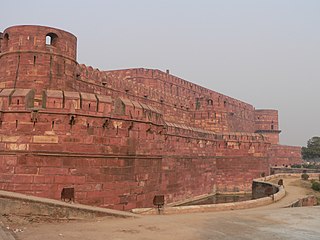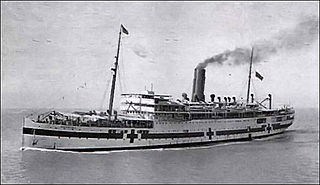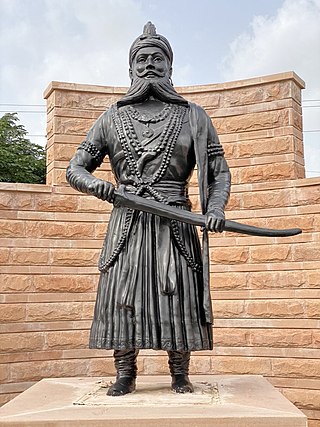
Jodhpur is the second-largest city in the Indian state of Rajasthan and officially the second metropolitan city of the state. It was formerly the seat of the princely state of Jodhpur State. Jodhpur was historically the capital of the Kingdom of Marwar, which is now part of Rajasthan. Jodhpur is a popular tourist destination, featuring many palaces, forts, and temples, set in the stark landscape of the Thar Desert. It is popularly known as the "Blue City" among people of Rajasthan and all over India. It serves as the administrative headquarters of the Jodhpur district and Jodhpur division.
Gorwar or Godwar, is a region of Rajasthan state in India, which lies in the southwest Rajasthan and borders with the state of Gujarat.
Pali is a city and capital division in Rajasthan state of India. It is the administrative headquarters of Pali District. It is on the bank of the river Bandi and is 70 km (43 mi) south east of West Jodhpur. It is known as "The Industrial City".

The Poona Horse is an armoured regiment in the Armoured Corps of the Indian Army. The regiment, known before independence as The Poona Horse, was raised as a regular cavalry regiment in the Bombay Presidency army of the East India Company. It was formed from the 3rd Regiment of Bombay Light Cavalry, raised in 1820, and the Poona Auxiliary Horse, raised about 1817–18. The latter unit was absorbed into the regular forces about 1860 and the two regiments later became the 33rd Queen Victoria's Own Light Cavalry and the 34th Prince Albert Victor's Own Poona Horse.

Pali district is a district in Rajasthan, India. The city of Pali is its administrative headquarters.

Jawai Bandh is a dam built across the Jawai river, a tributary of Luni river, in Rajasthan.
The Central India Campaign was one of the last series of actions in the Indian rebellion of 1857. A small British and Indian Army overcame a disunited collection of states in a single rapid campaign, although determined rebels continued a guerrilla campaign until the spring of 1859.
Sheoganj is a town in Sirohi District of Rajasthan state in India located on the bank of Jawai River. Sheoganj is the tehsil headquarters of Sheoganj Tehsil by the same name.

Narnaul is a city, a Municipal Council, and location of headquarters of the Mahendragarh district in the Indian state of Haryana. It is located in the National Capital Region of India.
The Battle of Badli-ki-Serai was fought early in the Indian Rebellion of 1857, or First War of Indian Independence as it has since been termed in Indian histories of the events. A British and Gurkha force defeated a force of sepoys who had rebelled against the British East India Company. The British victory allowed them to besiege and ultimately capture Delhi.

The Battle of Agra was a comparatively minor but nevertheless decisive action at the end of a prolonged siege during the Indian Rebellion of 1857.
The 83rd Regiment of Foot was a British Army line infantry regiment, which was formed in Ireland in 1793 for service in the French Revolutionary Wars. The regiment served in the West Indies, South Africa and the Peninsular War, and after the end of the wars with France spent much of the nineteenth century in colonial garrisons. Among other service, the 83rd fought in the Ceylon Great Rebellion of 1817–18, the Canadian Rebellions of 1837, and the Indian Rebellion of 1857. Under the Childers Reforms, the regiment amalgamated with the 86th Regiment of Foot to form the Royal Irish Rifles in 1881.
The Battles and Operations involving the Indian National Army during World War II were all fought in the South-East Asian theatre. These range from the earliest deployments of the INA's preceding units in espionage during Malayan Campaign in 1942, through the more substantial commitments during the Japanese Ha Go and U Go offensives in the Upper Burma and Manipur region, to the defensive battles during the Allied Burma campaign. The INA's brother unit in Europe, the Indische Legion did not see any substantial deployment although some were engaged in Atlantic wall duties, special operations in Persia and Afghanistan, and later a small deployment in Italy. The INA was not considered a significant military threat. However, it was deemed a significant strategic threat especially to the Indian Army, with Wavell describing it as a target of prime importance.

The Bengal Army was the army of the Bengal Presidency, one of the three presidencies of British India within the British Empire.
The 43rd Erinpura Regiment was a regiment of the British Indian Army. It originated in the three infantry companies of Meena, Bhil tribe of the Jodhpur Legion that stayed loyal to the British when the Legion revolted in 1857.

SS Erinpura was an E-class ocean liner of the British India Steam Navigation Company, built in 1911. She was the first British India ship built for Eastern service to be fitted with radio. She served in both World Wars. Enemy action in 1943 sank her in the Mediterranean Sea with great loss of life.
The British raised the Jodphur Legion in 1836 at Erinpura Cantonment in the north-east of the Sirohi State, Rajputana 25°9′N73°4′E, on the left bank of the Jawai River, about 6 miles from Erinpura Road.

Kushal Singh Champawat Rathore also known as Khushal Singh Champawat was the Thakur of a prominent Thikana of Auwa in Jodhpur State. During Indian rebellion of 1857, he defeated the British Army in the Battle of Bithoda and chelawas.










